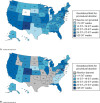Changes in Availability of Later Abortion Care Before and After Dobbs v. Jackson Women's Health Organization
- PMID: 39447180
- PMCID: PMC11630660
- DOI: 10.1097/AOG.0000000000005772
Changes in Availability of Later Abortion Care Before and After Dobbs v. Jackson Women's Health Organization
Abstract
Objective: To examine changes in availability of procedural abortion, especially in the second and third trimesters of pregnancy, since the U.S. Supreme Court ended federal protections for abortion in its Dobbs v. Jackson Women's Health Organization decision in 2022.
Methods: We used the Advancing New Standards in Reproductive Health Abortion Facility Database, a national database of all publicly advertising abortion facilities, to document trends in service availability from 2021 to 2023. We calculated summary statistics to describe facility gestational limits for procedural abortion for the United States and by state, subregion, and region, and we examined the number and proportion of facilities that offer procedural abortion in the second or third trimester of pregnancy.
Results: From 2021 to 2023, the total number of publicly advertising facilities providing procedural abortion decreased 11.0%, from 473 to 421. Overall, one-quarter of facilities (n=115) that had been providing procedural abortion in 2021 ceased providing services, and an additional 99 decreased their gestational limits. In contrast, 73 facilities increased their gestational limits, and 64 new facilities began providing or publicly advertising procedural abortion services. The number of facilities offering procedural abortion later in pregnancy decreased (327 to 309 providing 14 weeks of gestation or later, 60 to 50 providing 24 weeks of gestation or later), although the proportion of all facilities providing these services held steady. The greatest changes were in the South, where many facilities closed.
Conclusion: There have been substantial reductions in the number and distribution of facilities offering procedural abortion since the Dobbs decision, with critical decreases in the availability of later abortion services. Some facilities are positioning themselves to meet the needs of patients by opening new facilities, publicly advertising their services, or extending their gestational limits.
Copyright © 2024 The Author(s). Published by Wolters Kluwer Health, Inc.
Conflict of interest statement
Financial Disclosure The authors did not report any potential conflicts of interest.
Figures



Similar articles
-
Abortion Provision and Delays to Care in a Clinic Network in Washington State After Dobbs.JAMA Netw Open. 2024 May 1;7(5):e2413847. doi: 10.1001/jamanetworkopen.2024.13847. JAMA Netw Open. 2024. PMID: 38809551 Free PMC article.
-
Estimated Travel Time and Spatial Access to Abortion Facilities in the US Before and After the Dobbs v Jackson Women's Health Decision.JAMA. 2022 Nov 22;328(20):2041-2047. doi: 10.1001/jama.2022.20424. JAMA. 2022. PMID: 36318194 Free PMC article.
-
Provision of Medications for Self-Managed Abortion Before and After the Dobbs v Jackson Women's Health Organization Decision.JAMA. 2024 May 14;331(18):1558-1564. doi: 10.1001/jama.2024.4266. JAMA. 2024. PMID: 38526865 Free PMC article.
-
Public health and clinical implications of Dobbs v. Jackson for patients and healthcare providers: A scoping review.PLoS One. 2024 Mar 29;19(3):e0288947. doi: 10.1371/journal.pone.0288947. eCollection 2024. PLoS One. 2024. PMID: 38551970 Free PMC article.
-
Post-Roe v Wade psychiatry: legal, clinical, and ethical challenges in psychiatry under abortion bans.Lancet Psychiatry. 2024 Oct;11(10):853-862. doi: 10.1016/S2215-0366(24)00096-8. Epub 2024 May 22. Lancet Psychiatry. 2024. PMID: 38795722 Review.
References
-
- Later Abortion Initiative. What does abortion later in pregnancy entail? Accessed September 20, 2024. https://laterabortion.org/sites/default/files/lai_procedure_revised.pdf
-
- National Academies of Sciences Engineering and Medicine. The safety and quality of abortion care in the United States. National Academies Press; 2018 - PubMed

